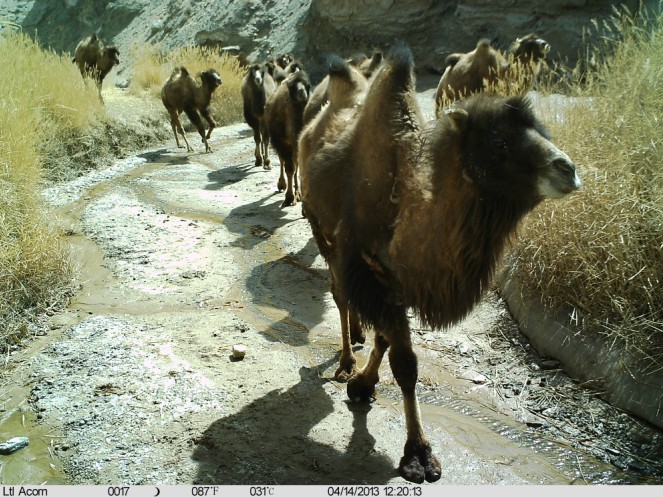Chinese scientists plan to apply Earth Observation technologies comprehensively to protect the critically endangered wild camels, including airborne and satellite remote sensing, satellite positioning, geographical information system (GIS) and wireless sensors networks, etc. The project is made up of mapping the range of the wild camels based on GPS tracking data, population assessment, water resource protection, and eliminating the negative effect of hybridization of wild camel and domesticated ones. Education will also play an important role in this project.
An International Research Center for Wild Camel Conservation(IRCWC) has been co-established this year by the Institute of Remote Sensing and Digital Earth (RADI, under the Chinese Academy of Sciences),the Lop Nur Wild Camel National Nature Reserve (LWCNR, in Xinjiang) and the Wild Camel Protection Foundation (WCPF, in United Kingdom). It coordinates with the strength from multi-discipline as well as various departments in order to research and protect wild camels together.
Prof. Liu Shaochuang, a RADI researcher, has attached Satellite Positioning Trackers to 10 wild camels in Lop Nur and ranges of Arjin Mountains, which are two of four wild camel’s separated habitats in the world. Based on them, the first batch of tracking data was acquired. He is also collaborating with the scientists in Mongolian Academy of Sciences in research and protection wild camels in Mongolia. Thereafter, multiple cooperative research projects will be carried out.
"By satellite tracking wild camels in both China and Mongolia, their distribution and migration can be fully discovered and threats can be estimated. Therefore, the accurate and reliable evidence will be provided for effective protection of wild camels and their habitat," Liu Shaochuang says.
But he indicated that the currently being used tracker will not easily become popular, as it has to depend on the Globalstar or Iridium satellites communication system to transfer the tacking data. With the increasing improvement of Chinese 'Beidou' system, Prof. Liu's team will develop the new wild animal tracker based on 'Beidou' Satellite Navigation System, which is an important step for its navigation and positioning products to become worldwide.
The survey revealed that there were fewer than 1,000 wild camels still alive all over the world. But the detailed amount of wild camels could not be determined even today. Due to their scarcity in number but their migration in large area, mainly in the severely draught deserts and Gobi regions, the traditional wild animal population assessment methods, mainly through visual observation and on-site counting, do not effective to wild camels.
"Based on aerial photos and remote sensing images of high resolution satellite, IRCWC can calculate the number of wild camels in China and Mongolia, through manual or automatic recognition technology", Liu Shaochuang says, "In addition, satellite remote sensing technology is capable of monitoring illegal mining activities effectively in the habitats of the wild camels."
In some regions of wild camels habitat,the hybridization between domesticated camels and wild ones are occurring, which caused big threat to the wild camel's genome integrity. Regarding to this, IRCWC researchers will carry out Unmanned Aerial Vehicle(UAV) surveillance and recognize every herd of wild camels clearly, in order to separate the domesticated ones from them.
Besides, scientists show much interest in applying Wireless Sensor Network(WSN) technology to preserving the wild camel. The WSN was originally motivated by military applications. It is an unattended ground sensor network, made up of various kinds of sensors, for sound, seismic, infrared, electromagnetism,chemistry and so on. Its application has extended to civil fields, e.g., long-term environmental monitoring, anti-terrorism, public security, industry and medical treatment, etc.
"It is an innovative application for WSN technology to be used for wild animal protection, with specific sensors by special development. But it is very suitable for preserving wild camels", says Liu Shaochuang.
He says that too many people involved in tourism, exploration or mining have illegally entered the habitat of wild camels. It has severely threatened their existence. Because their movement occupies large area, with harsh environment and very limited management staff, it is necessary to deploy the WSN in order to make large area monitoring come true.
Some boundary area to Mongolia in Xinjiang Uygur Autonomous Region and Gansu Province, China, is also the habitat of wild camels. Unfortunately, the barbed iron wire fence along the country border severely hampered the migration of wild animals, including wild camels.
"If a trans-boundary nature reserve could be established on the border of China and Mongolia, and the fence might be removed, the unattended ground sensor network would help in solving the cross-border issue on the regulatory staff", Liu Shaochuang says.

Wild camel images captured by camera traps.